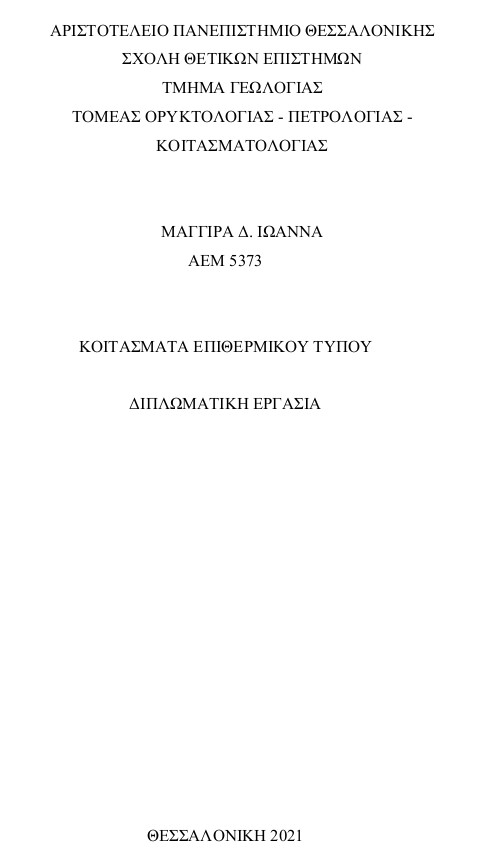
Κοιτάσματα επιθερμικού τύπου = Epithermal type deposits.
Περίληψη
Η παρακάτω εργασία αποτελεί μια σύνοψη όλων των χαρακτηριστικών γνωρισμάτων ενός κοιτάσματος επιθερμικού τύπου.Τα επιθερμικά κοιτάσματα εμφανίζονται σε ένα γεωτεκτονικό περιβάλλον υποβύθισης μίας ωκεάνιας τεκτονικής πλάκας κάτω από μια άλλη ηπειρωτική, και με ταυτόχρονη άνοδο μάγματος και μεταφορά ρευστών.Στην εργασία, αναφέρονται η ταξινόμηση τους σε χαμηλής, υψηλής και ενδιάμεσης θείωσης κοιτάσματα καθώς όλα τα ιδιαίτερα χαρακτηριστικά τους, όπως ορυκτά της μεταλλοφορίας, μορφή των μεταλλοφόρων σωμάτων, πηγή προέλευσης των ρευστών, κοιτάσματα καθώς όλα τα ιδιαίτερα χαρακτηριστικά τους, όπως ορυκτά της μεταλλοφορίας, μορφή των μεταλλοφόρων σωμάτων, πηγή προέλευσης των ρευστών, μητρικό πέτρωμα ξενιστής κ.ά., Επιπλέον, αναφέρονται αναλυτικά οι υδροθερμικές εξαλλοιώσεις που είτε προϋπάρχουν προϋπάρχουν στα ορυκτά του πετρώματος ξενιστές, είτε αναπτύσσονται κατά τη δημιουργία της μεταλλοφορίας καθώς και η ζώνωση των κοιτασμάτων αυτών. Τέλος, παρατίθενται μερικά παραδείγματα τόσο παγκόσμιων όσο και Ελληνικών εμφανίσεων των κοιτασμάτων επιθερμικού τύπου.
This diploma thesis is a summary of all the features that characterize an epithermal type deposit. . The epithermal deposits appear in a tectonic environment with the subduction of an oceanic lithosphere below below a continental lithospheric slab, causing a contemporaneously rise of magma and fluid circulation.Their special features such as the ore and hydrothermal minerals, the form of the ore bodies, the origin of the fluids, , the host rocks etc. are further discussed. All these data that are used in order to discriminate them from other types of deposits and also to classify the epithermal deposits in subtypes based on their sulfidation state.Subsequently, the different types of hydrothermal alteration are discussed whether they pre-existed in the minerals of the host rocks, , or they were formed during the mineralization process form the hydrothermal fluids.Last but not least, several examples of global and Greek epithermal type deposits, are briefly described.
Πλήρες Κείμενο:
PDFΑναφορές
Κίλιας Σ. (2006). Έρευνα εντοπισμού για επιθερμικά κοιτάσματα Au (Cu,Ag).
Μέλφος Β., Επιθερμικά κοιτάσματα ευγενών και βασικών μετάλλων - [PDF Document]
Alfieris, D., Voudouris, P., & Spry, P. G. (2013). Shallow submarine epithermal Pb-Zn-Cu-Au-Ag-Te mineralization on western Milos Island, Aegean Volcanic Arc, Greece: Mineralogical, geological and geochemical constraints. Ore Geology Reviews, 53, 159–180. https://doi.org/10.1016/j.oregeorev.2013.01.007
Border, A., Constantinides, D., Michael, C. (1999). Discovery and evaluation of the Sappes gold deposit, northeastern Greece, in: Currie, D., Nielsen, K.No Title.
Chang, Z., Hedenquist, J. W., White, N. C., Cooke, D. R., Roach, M., Deyell, C. L., Garcia, J., Gemmell, J. B., McKnight, S., & Cuison, A. L. (2011). Exploration tools for linked porphyry and epithermal deposits: Example from the mankayan intrusion-centered Cu-Au district, Luzon, Philippines. Economic Geology, 106(8), 1365–1398. https://doi.org/10.2113/econgeo.106.8.1365
Hedenquist, J.W., Izawa, E., Arribas Jr, A., & White, N. C. (1995). Epithermal gold deposits: Styles, Characteristics, and Exploration: Resource Geology Special Publication. SEG Newsletter, 23, 9–13.
Hedenquist, Jeffrey W. (2000). Exploration for Epithermal Gold Deposits Chapter 7 Exploration for Epithermal Gold Deposits. Reviews in Economic Geology, 13(l), 245–277.
Hitchman, S. P. and Espi, J. O. (1997). Zonation, mineralization, paragenesis and rock types of Nena high sulfidation copper-gold deposit, Papua New Guinea.
Melfos, V., & Voudouris, P. (2017). Cenozoic metallogeny of Greece and potential for precious, critical and rare metals exploration. Ore Geology Reviews, 89, 1030–1057. https://doi.org/10.1016/j.oregeorev.2017.05.029
Sillitoe, R. H. (2015). Epithermal paleosurfaces. Mineralium Deposita, 50(7), 767–793. https://doi.org/10.1007/s00126-015-0614-z
White, N. C., and Hedenquist, J. W. (1990). Epithermal environments and styles of mineralization: variations and their causes, and guidelines for exploration. Journal of Geochemical Exploration, 36(1-3), 445-474.
Εισερχόμενη Αναφορά
- Δεν υπάρχουν προς το παρόν εισερχόμενες αναφορές.
